
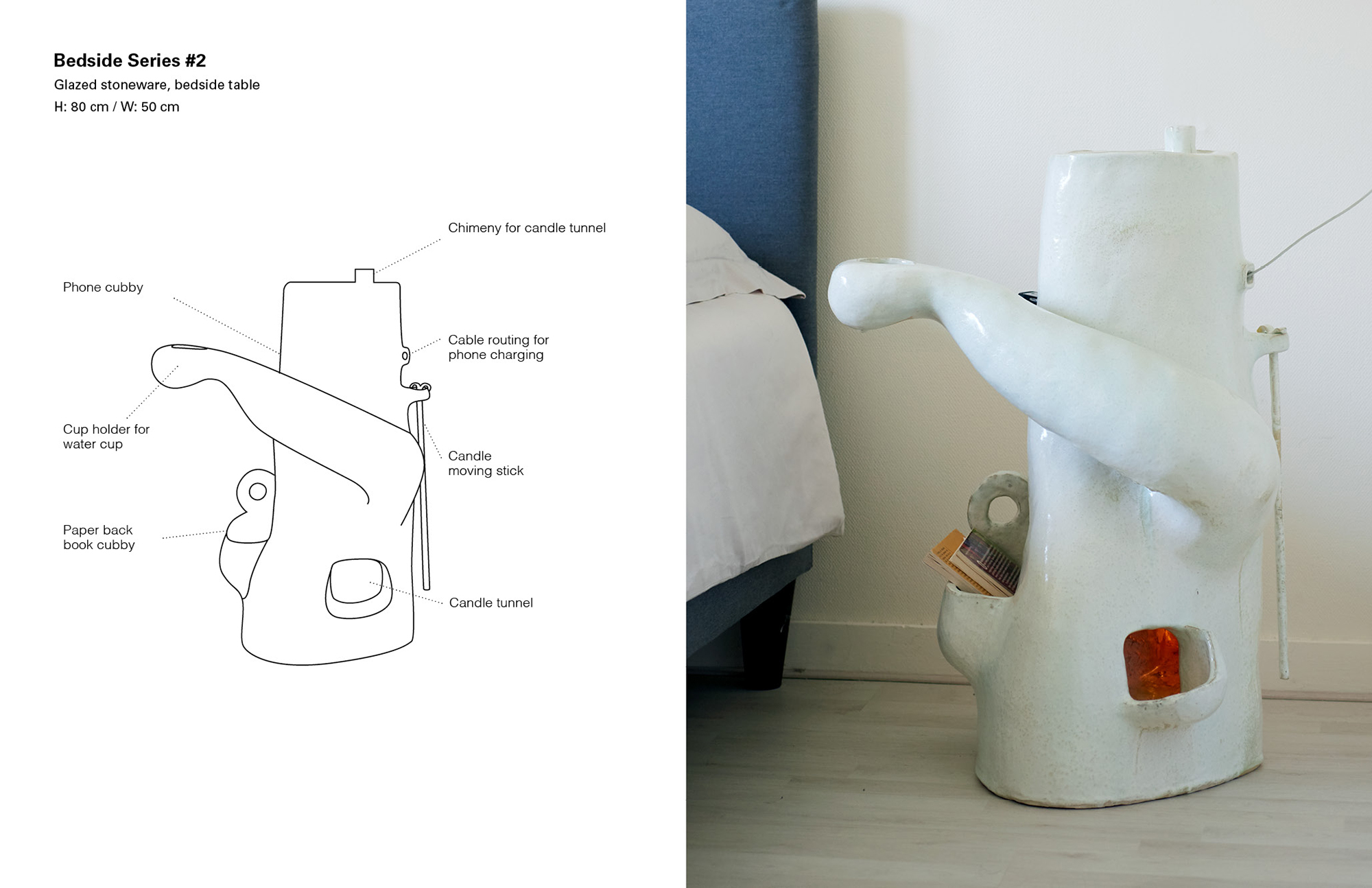
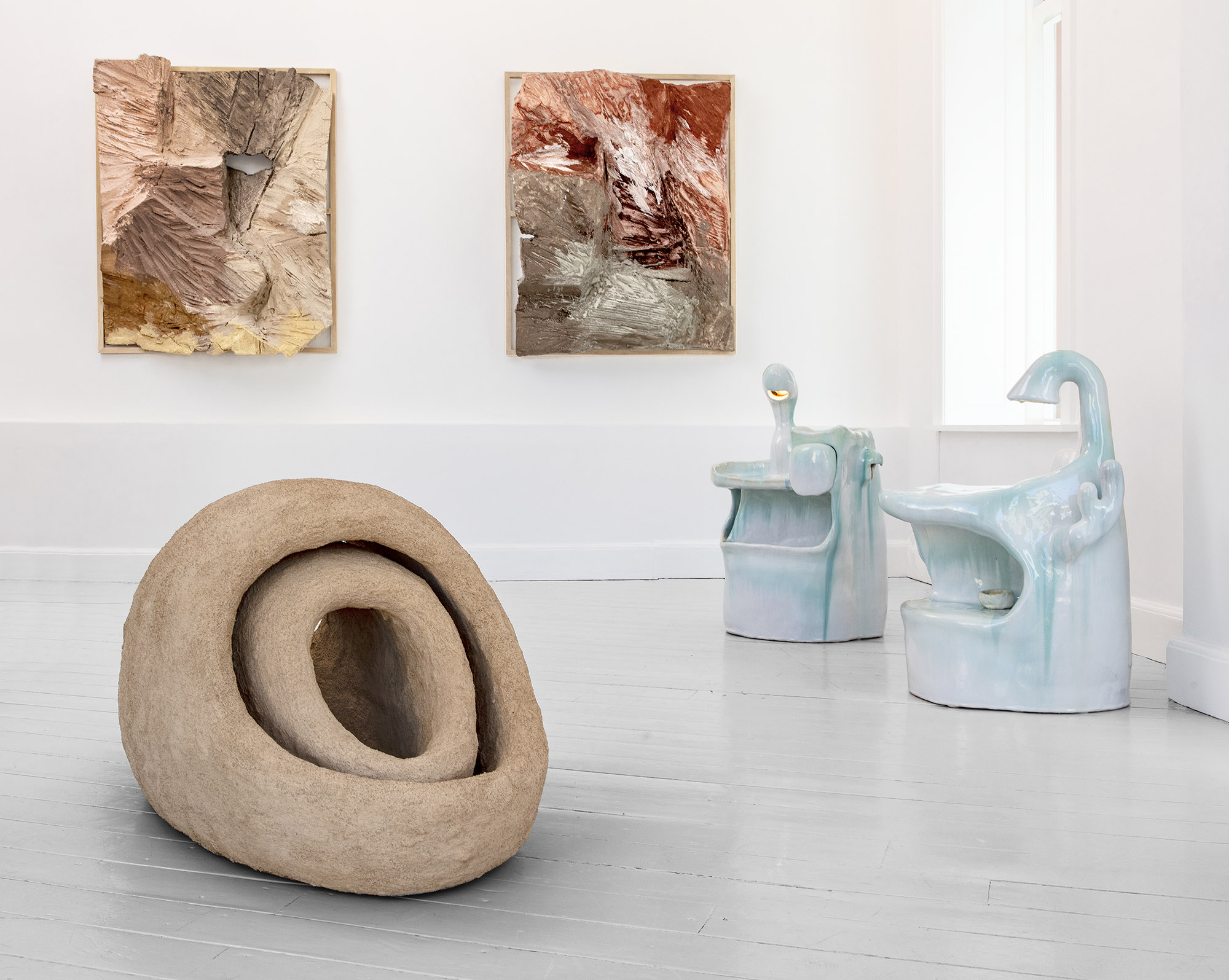
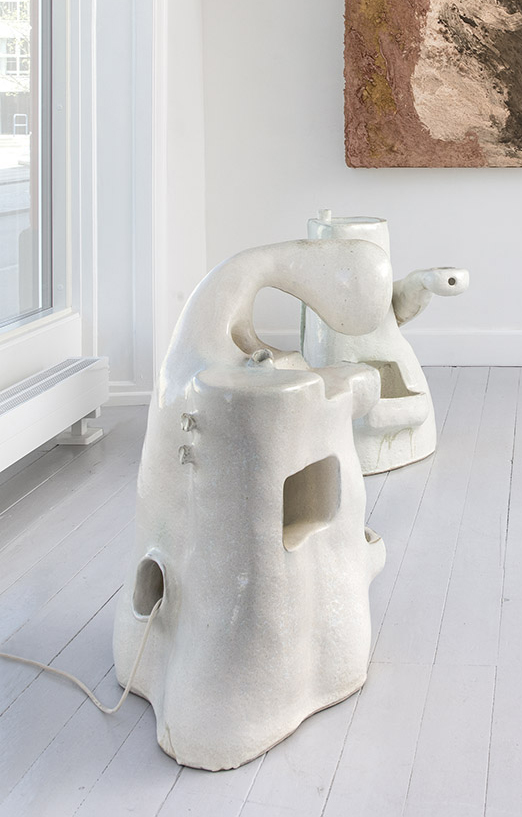
What do you need by your bedside? These objects were built from that question, and this shape would change depending on an individuals personal bedtime routine.
Photography above:
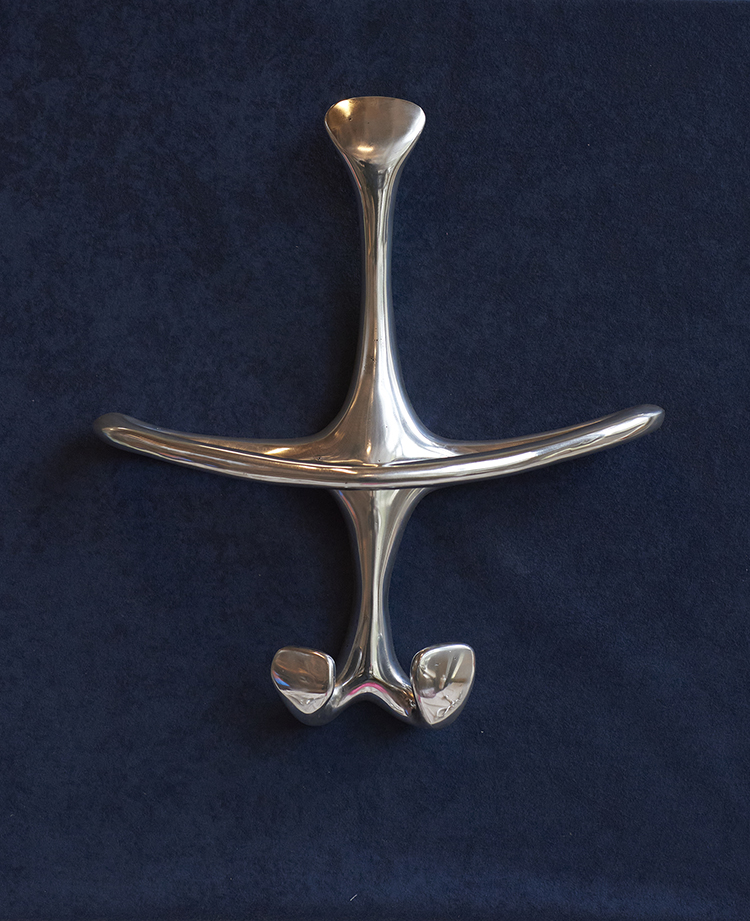



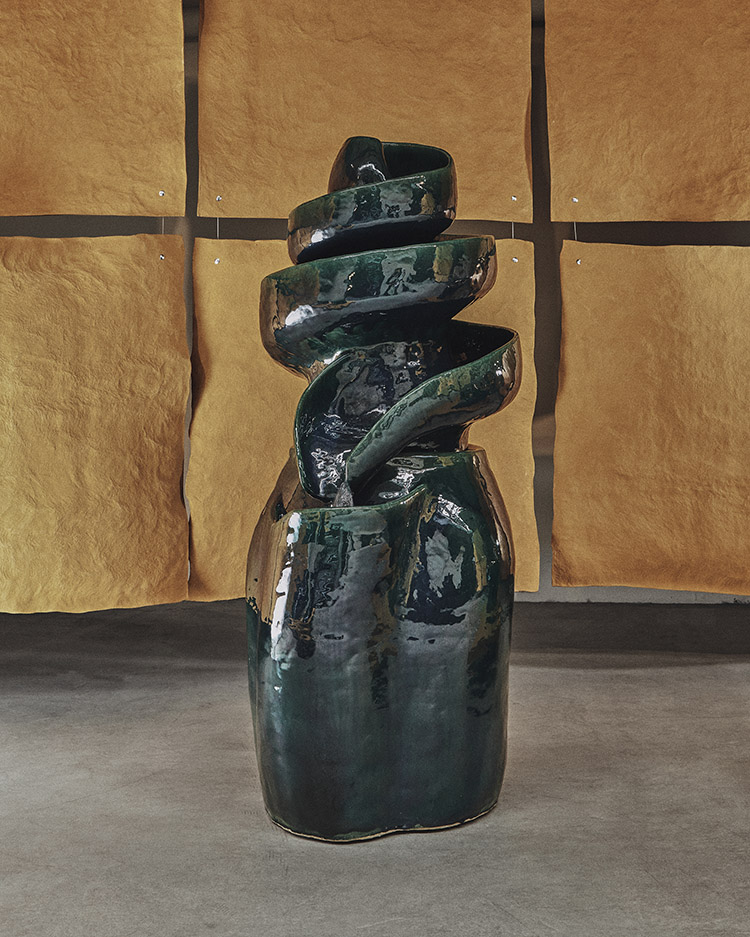
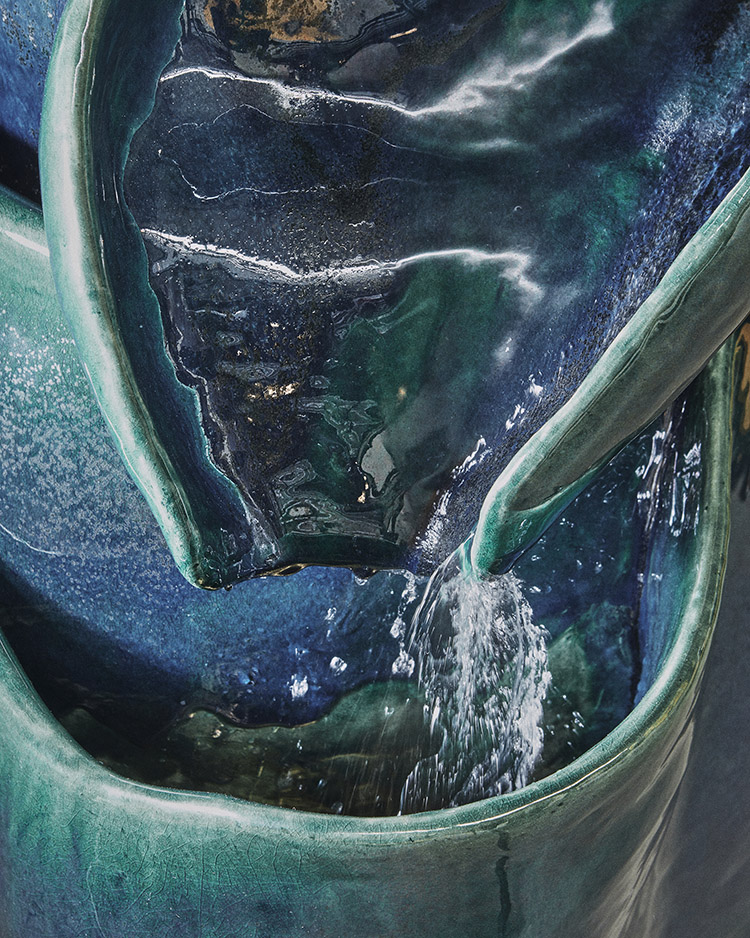
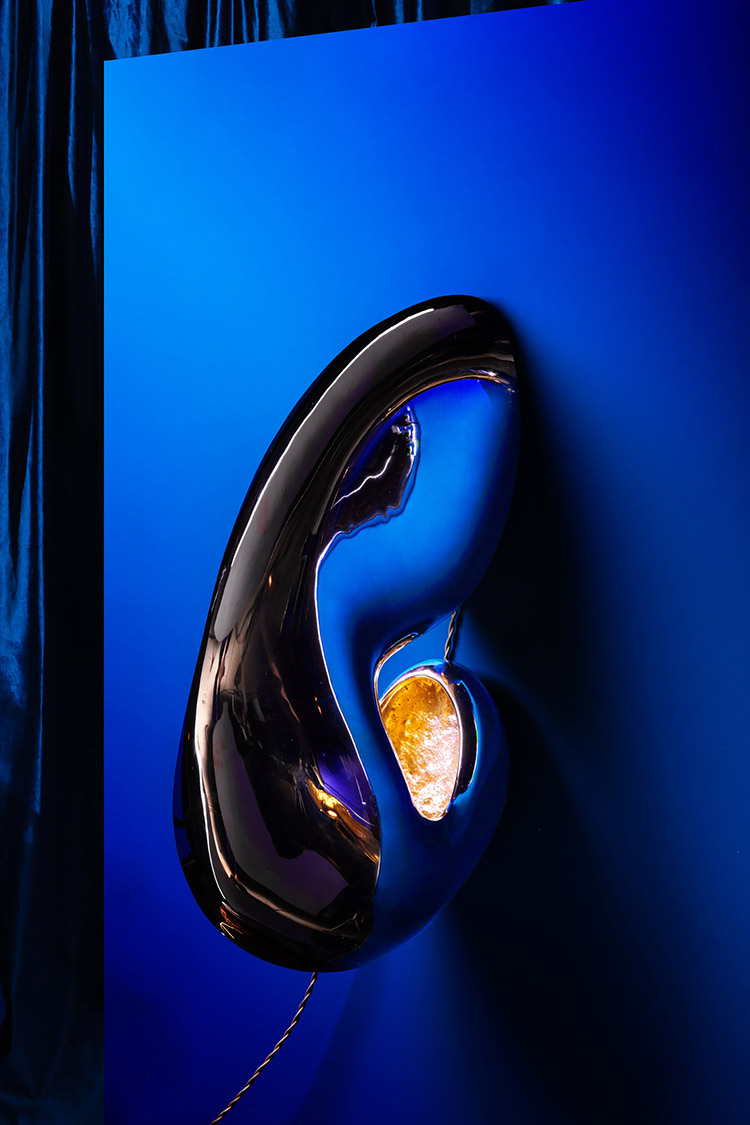

Lost wax bronze lamp
Photography: Matteo
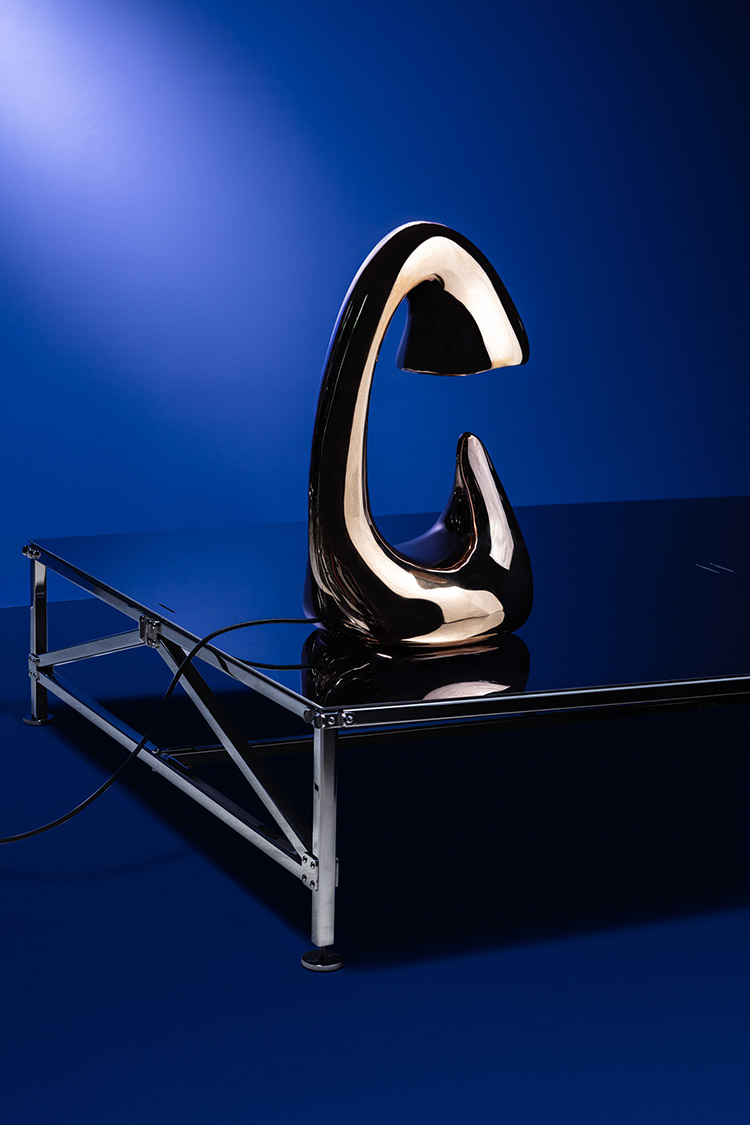

Lost wax bronze lamp
Picture #1 Photography: Matteo/Brassless, Cast @MakeEindhoven
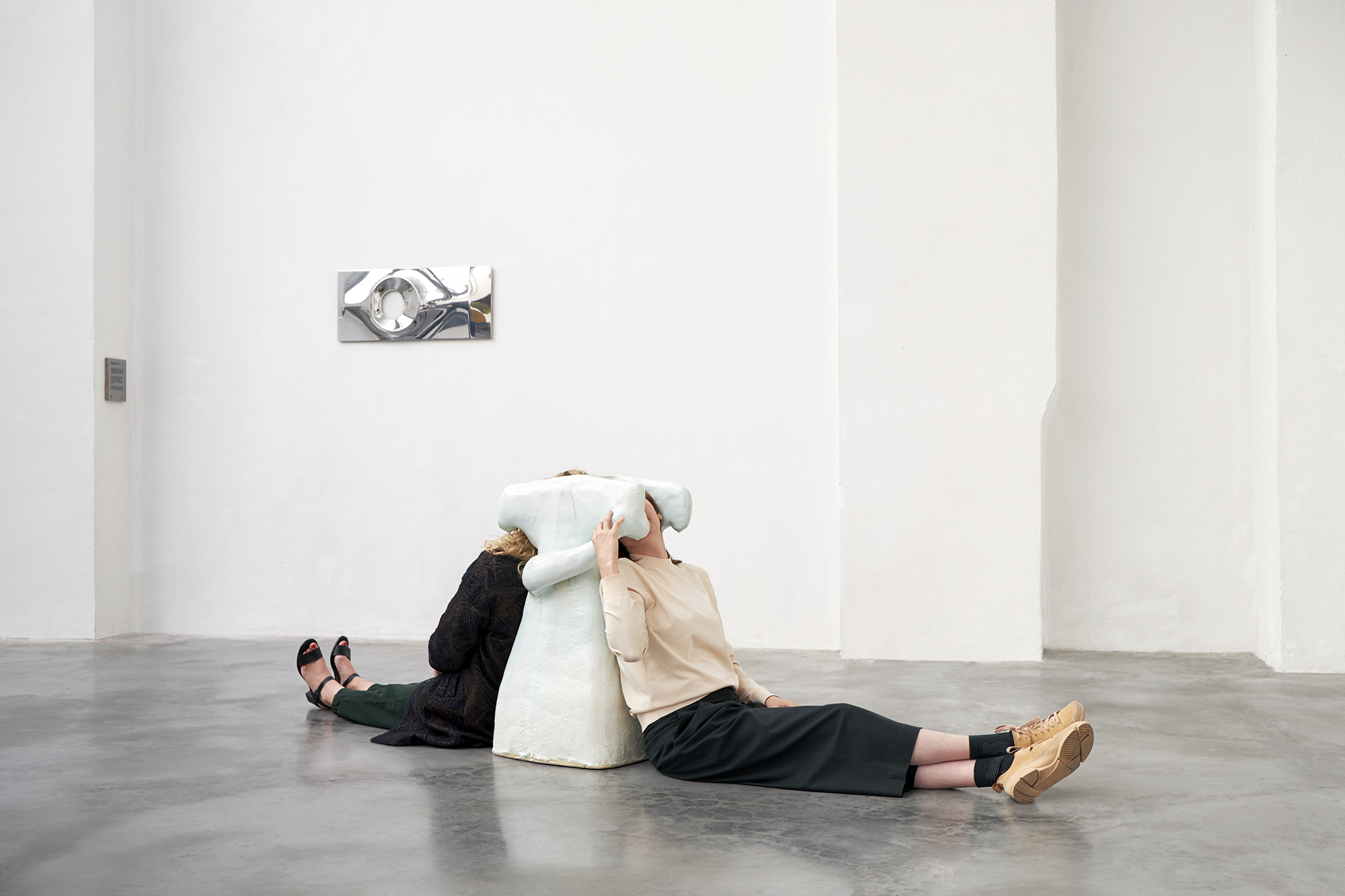

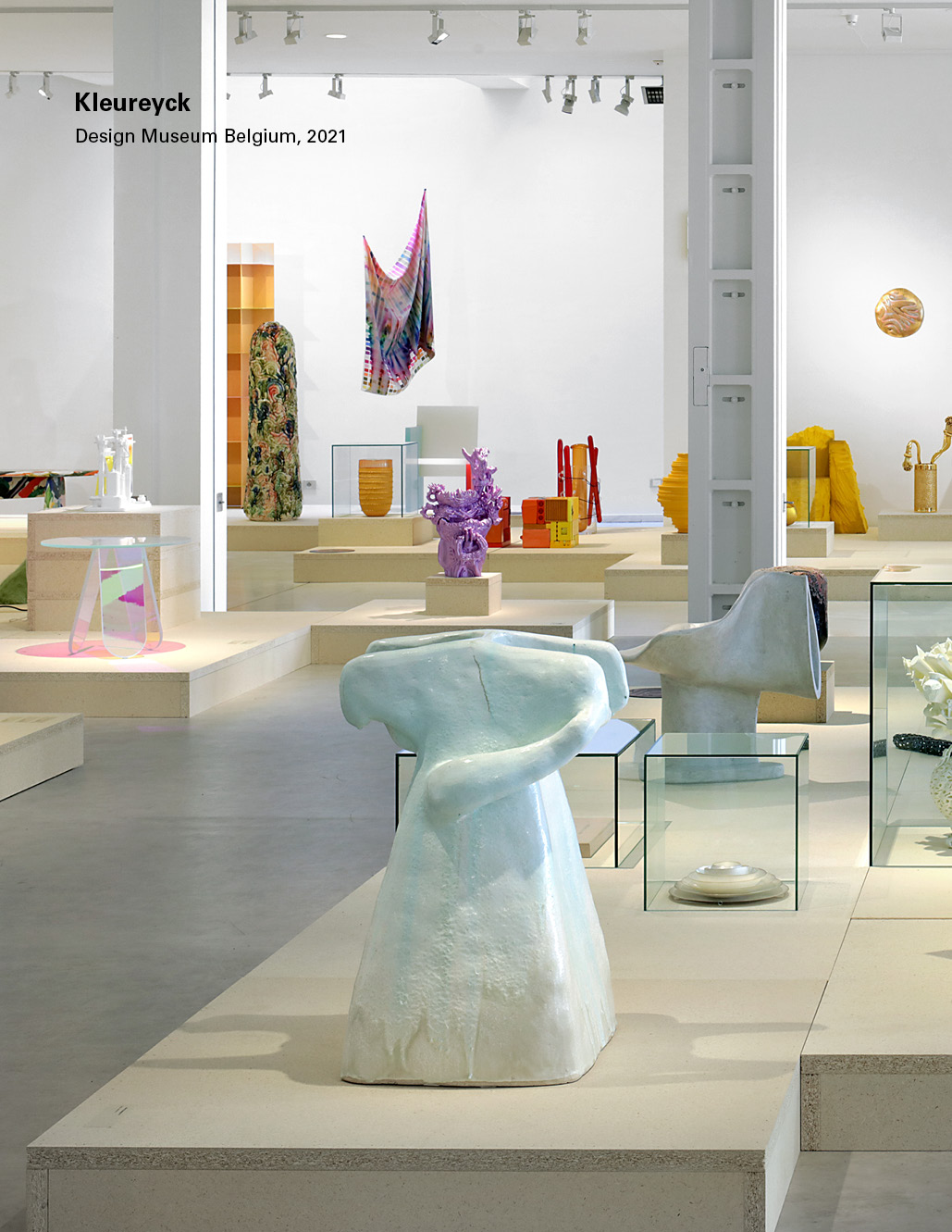
The echo chamber, a large ceramic vessel, is a tool for closed loop communication for a lone person or pair of individuals. When two visitors enter, they can communicate without seeing each other as pipes connect the ear of one with the mouth of the other, and vice versa. All the pipes feed to the middle of the body where they reverberate and travel. A circle is created, a loop between what is said and heard.
Photography above: Ronald Smits and Dutch Invertuals
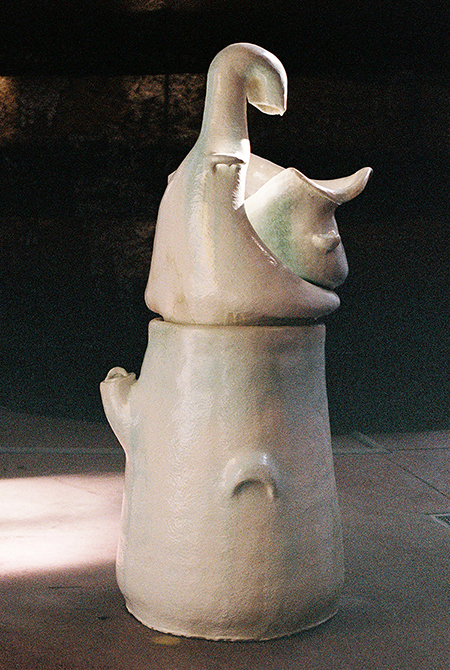
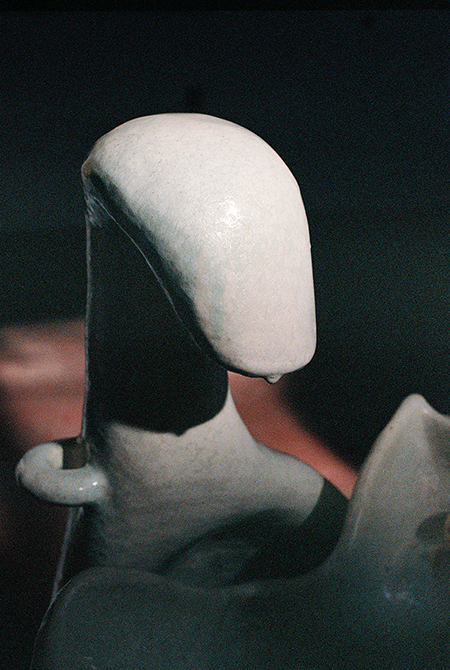

Sink and hand washing station design
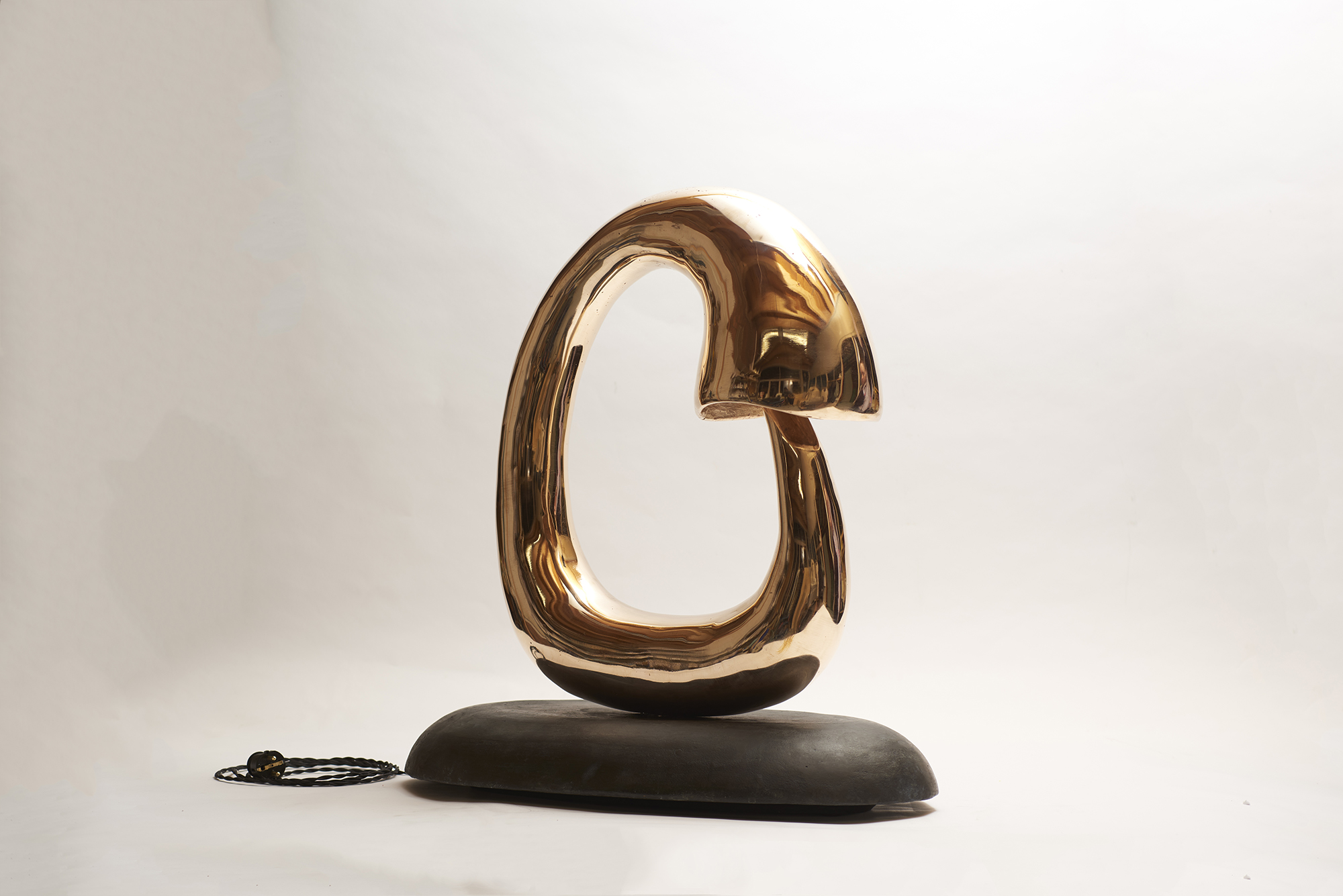
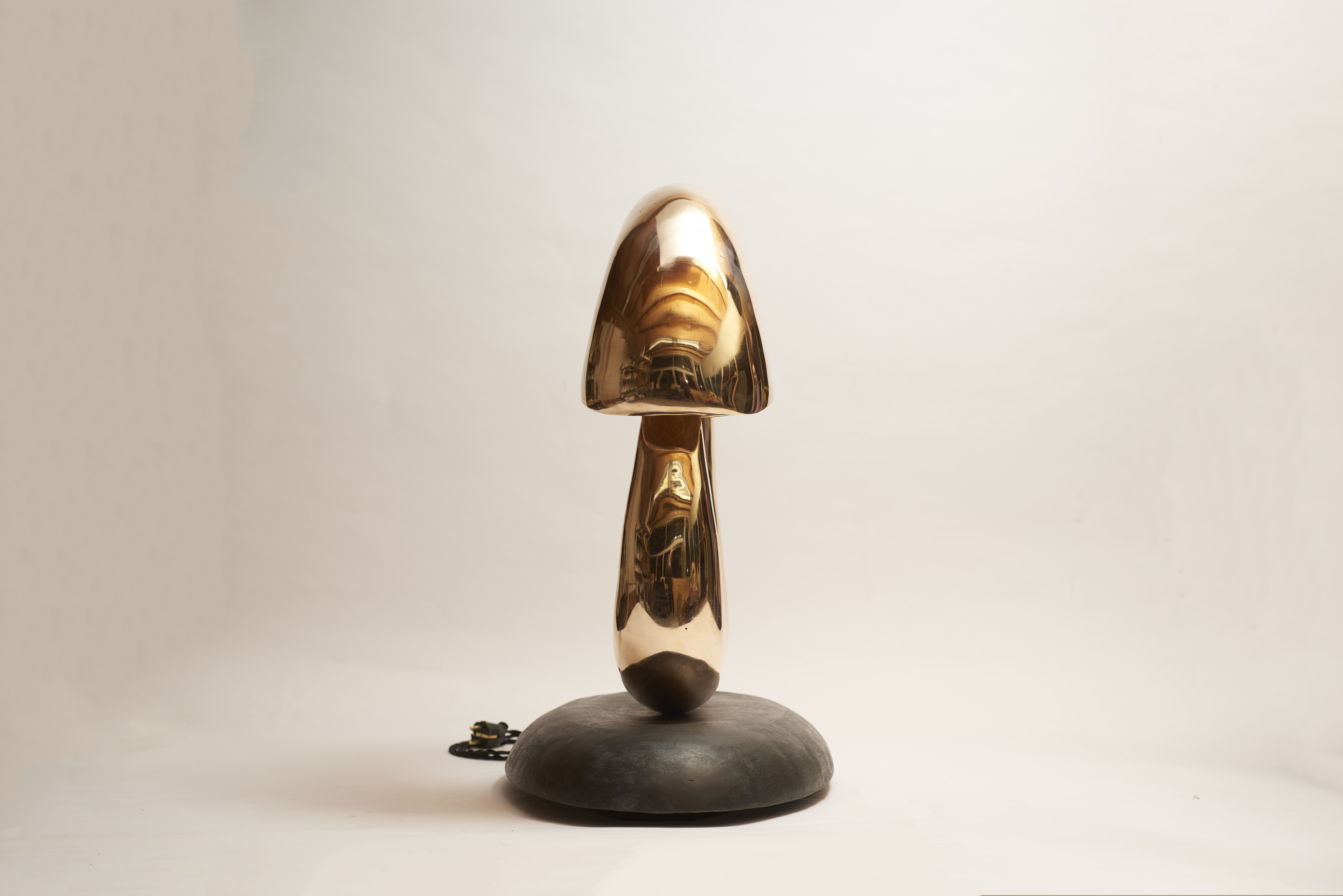
The title of this piece references the ‘anglerfish’ (the fish) and an ‘angler’ (the fisherman). The anglerfish is an ambush predator that lures prey into it’s mouth using an antenna with a light on the end that glows brightly in the dark depths of the ocean. In vaguely similar fashion users of the ‘Angler’ lamp will find the switch located inside the interior of the piece where the light is emitting from.
Secondly the piece is a reference to the Ouroboros, a symbol that can be found in the written histories of different ancient civilizations all over the world. I find it fascinating that cultures from all over the planet, that had no interaction or knowledge of one another, created the same symbol and ascribed significance to it. Most often the Ouroboros is depicted as a snake or dragon eating its own tail. Its symbolic and cultural value differs from one culture to another, however the Swiss psychologist and psychoanalyst Carl Jung maintained that the unexplainable global proliferation the symbol was a result of its archetypical significance in the collective unconscious.
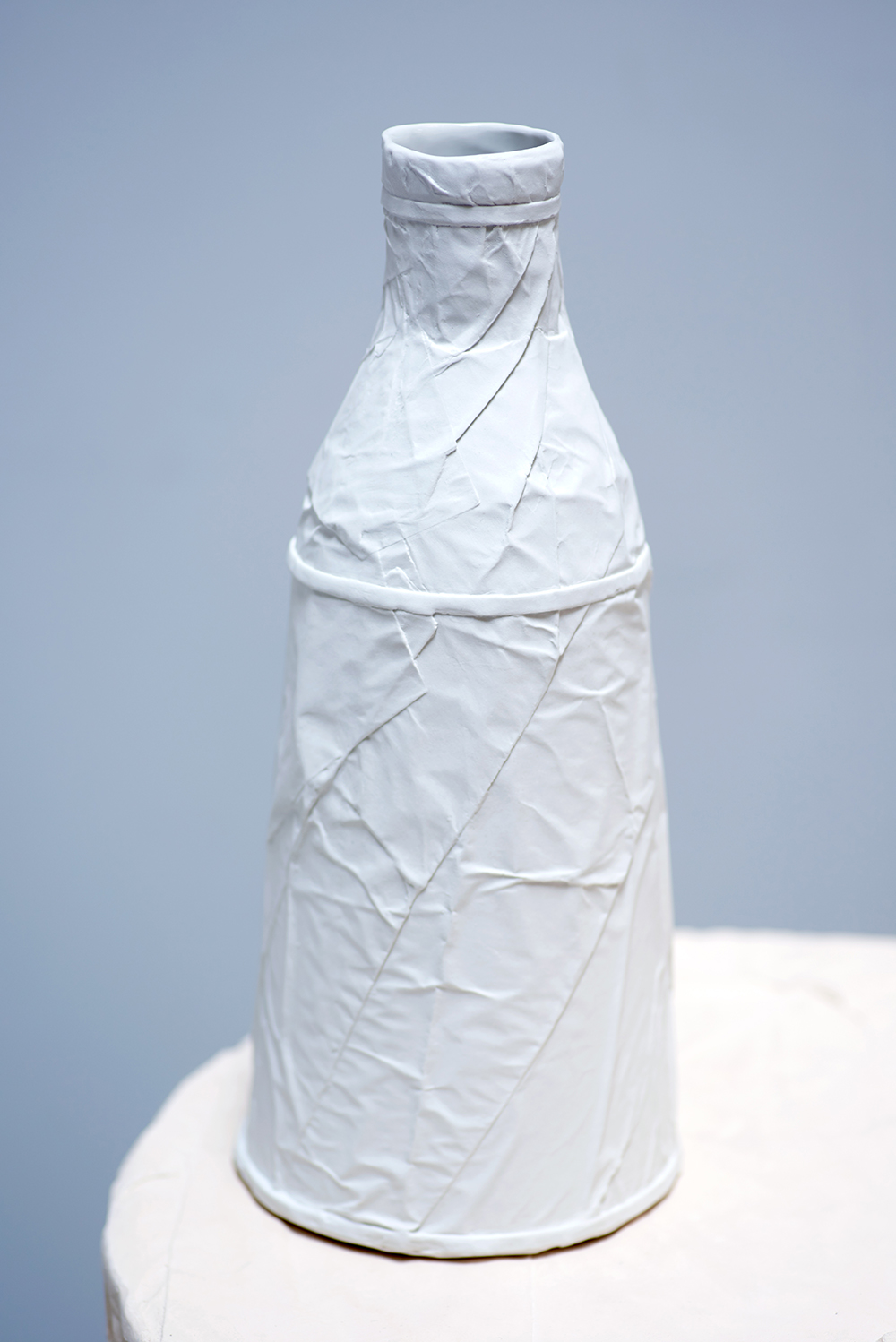

The central theme in the Form Bandit collection is transformation through wrapping. The project involves taking found objects and wrapping them with paper to conceal the original form, then making plaster moulds and using a special plemp moulding process. This enables me to reproduce the objects as massive ceramic pieces while still maintaining the fine detail of creased, wrapped paper. The objects are finished without glaze.
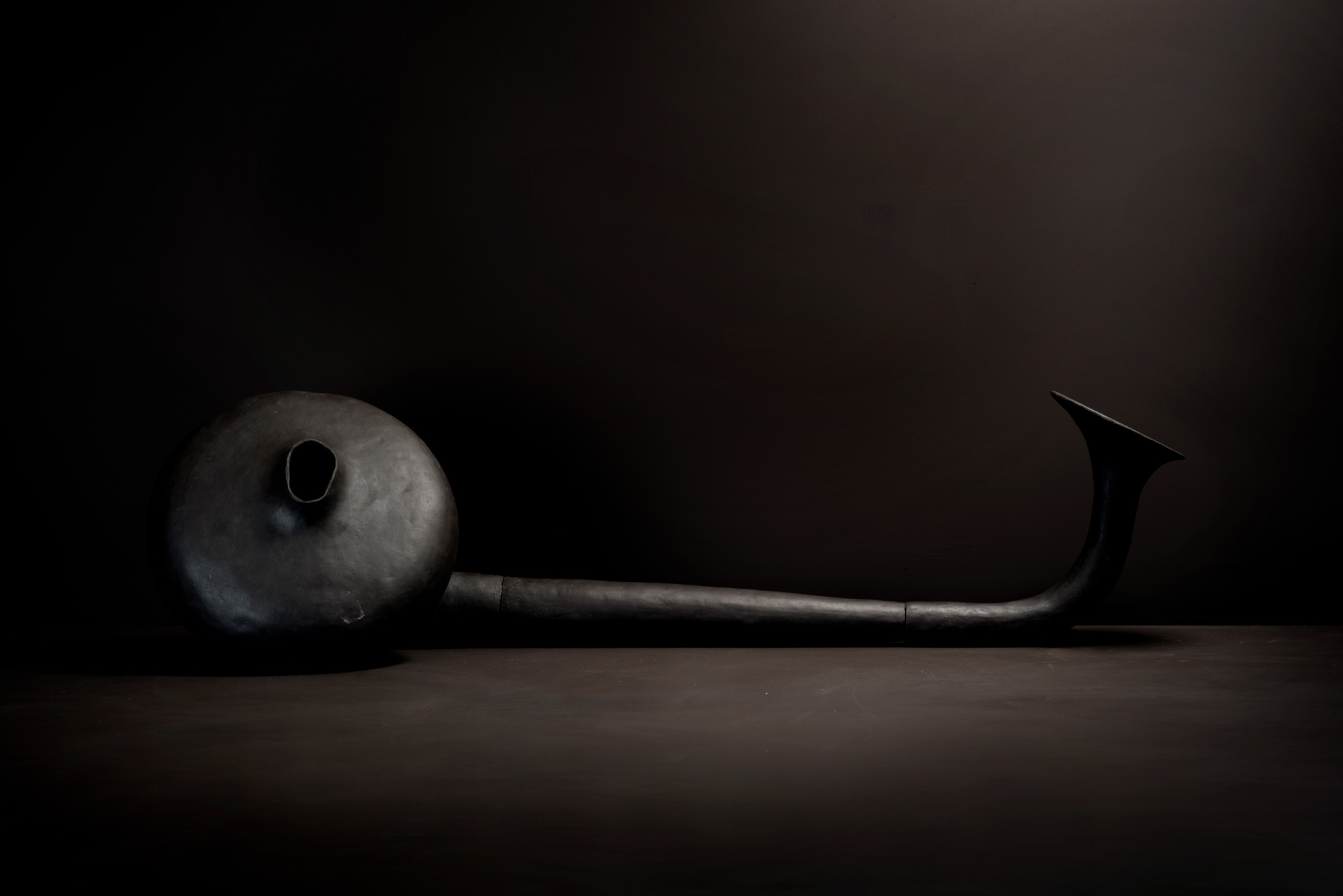
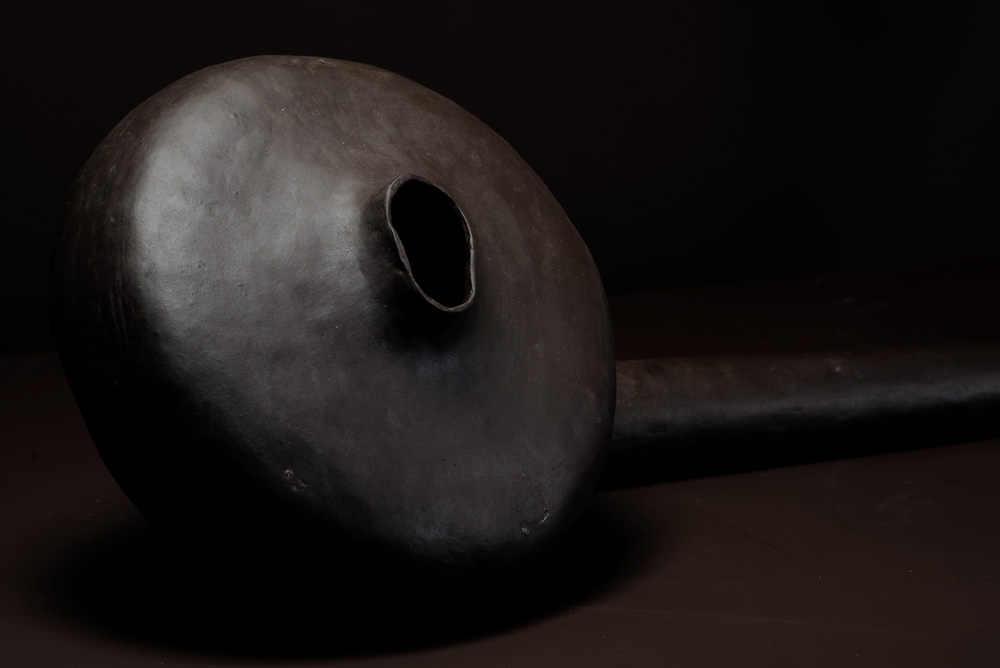
The Earhorn is an intermediary for an intimate message. It is based on the sensation of talking in someone’s ear, and conversely having someone whisper into your own. The bulbous opening on the left is where the ear should be inserted, and the opening on the right is for speaking.
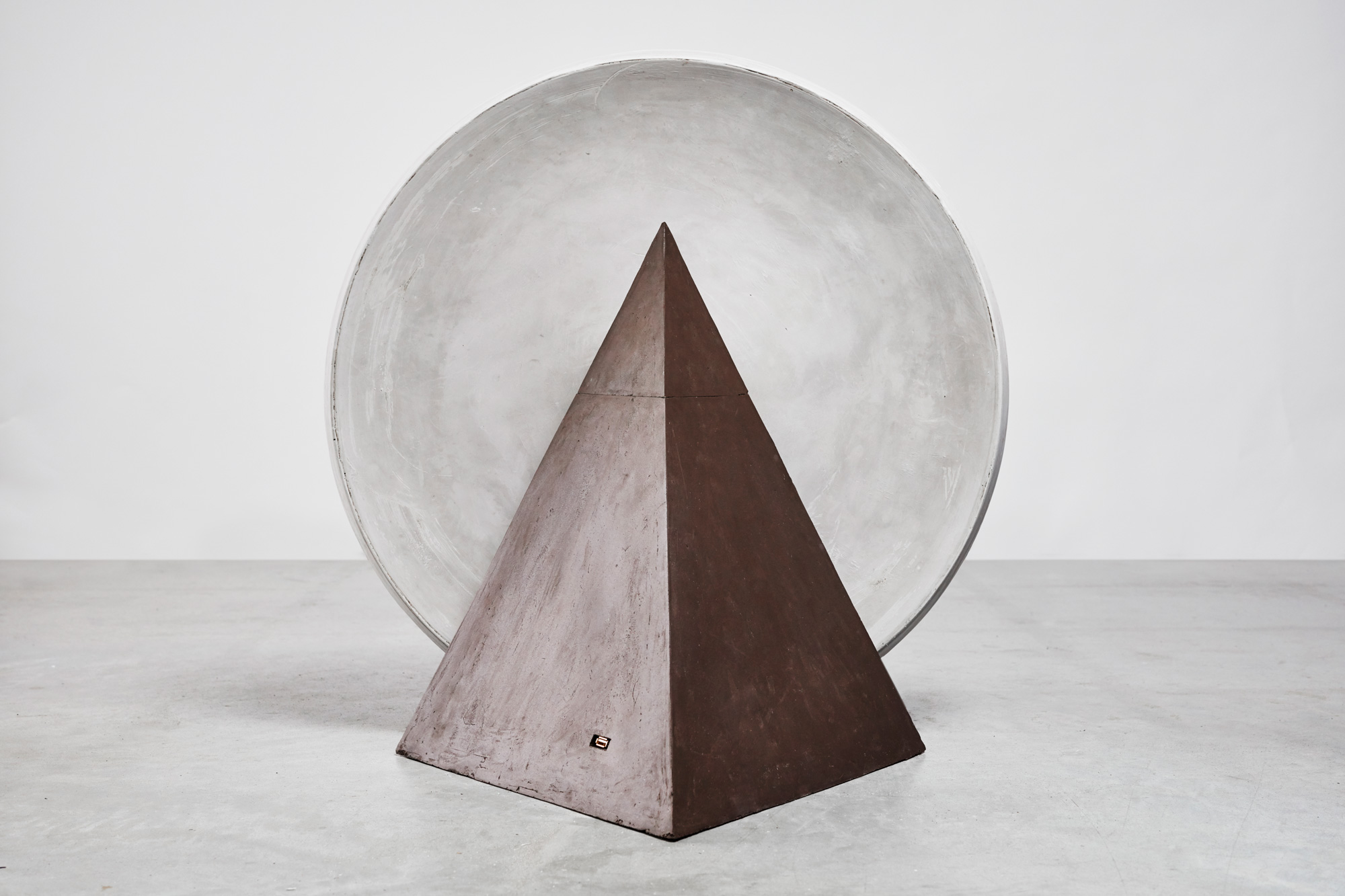

The Flywheel is a response to the thought that the biggest shift is not technology itself but the perception we have towards energy. The USB port at the base of the charger is powered by the user spinning a large clay wheel that hangs between two pyramids.
Although the mass of the wheel is such that one spin sustains the rotation for several minutes, users would need to spend an entire afternoon spinning the large, heavy wheel to fully charge their device.
The aim of the Flywheel is to give a human scale perspective on the amount of energy we carry around in our phones.
Photography: Ronald Smits and Dutch Invertuals
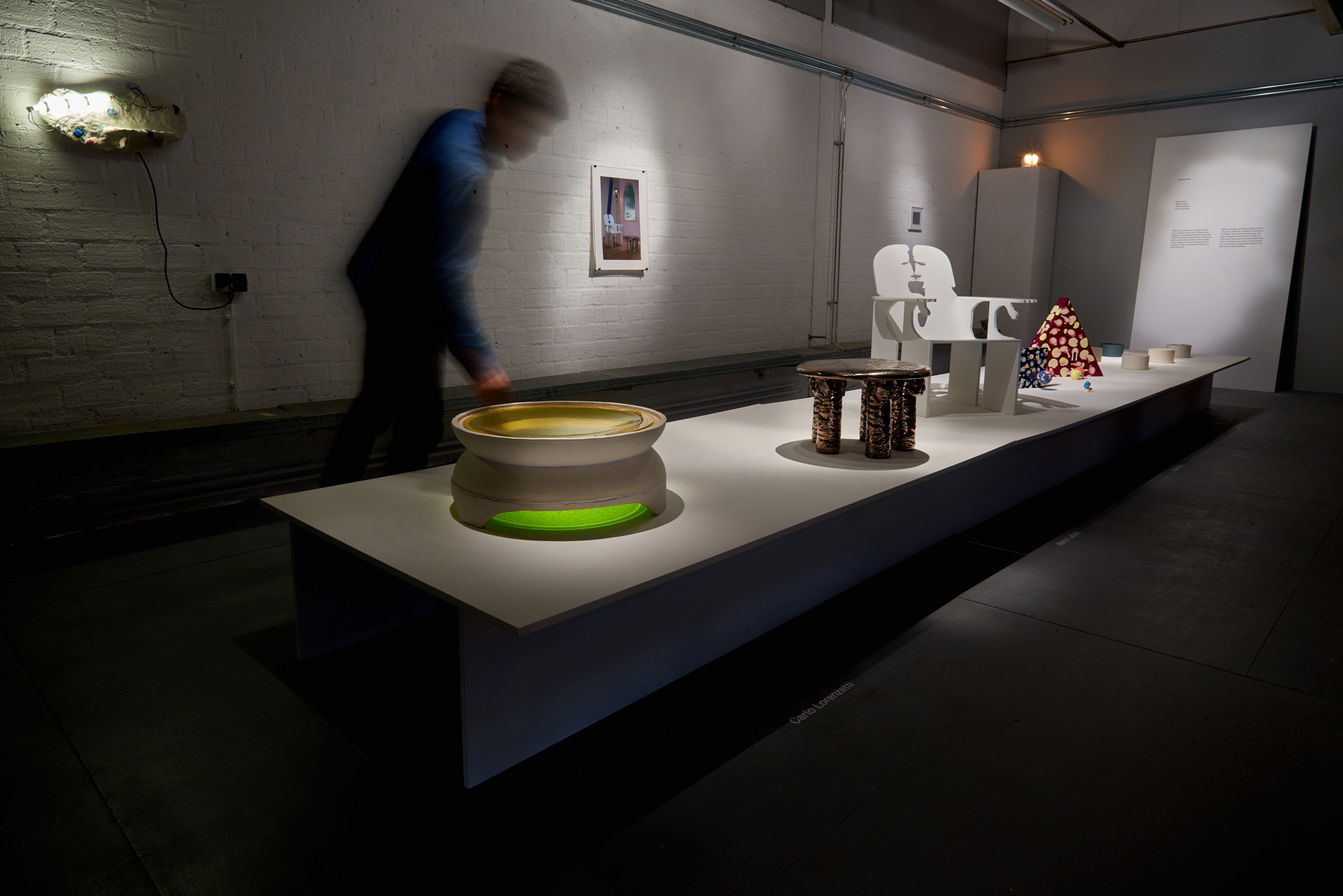
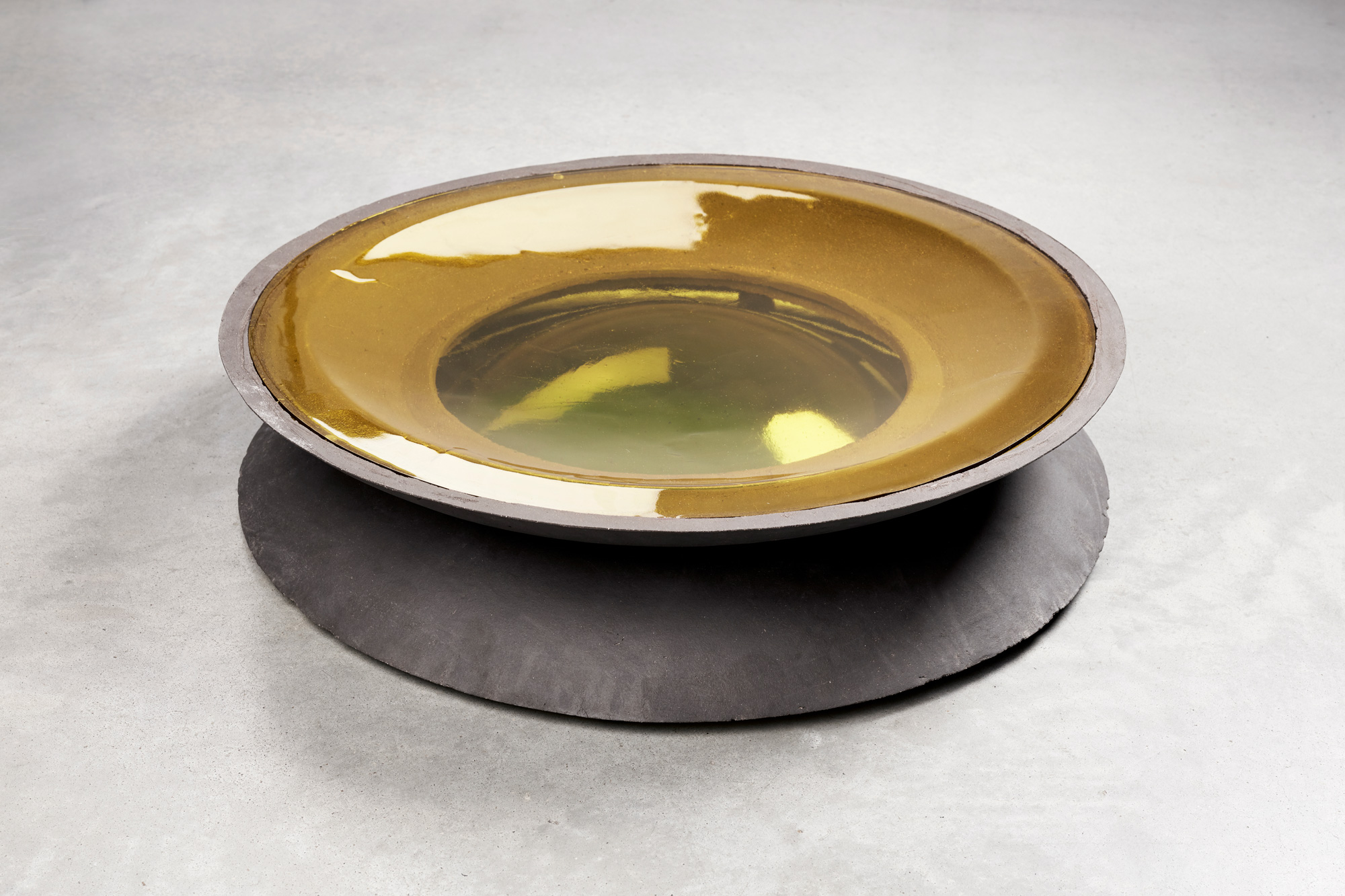
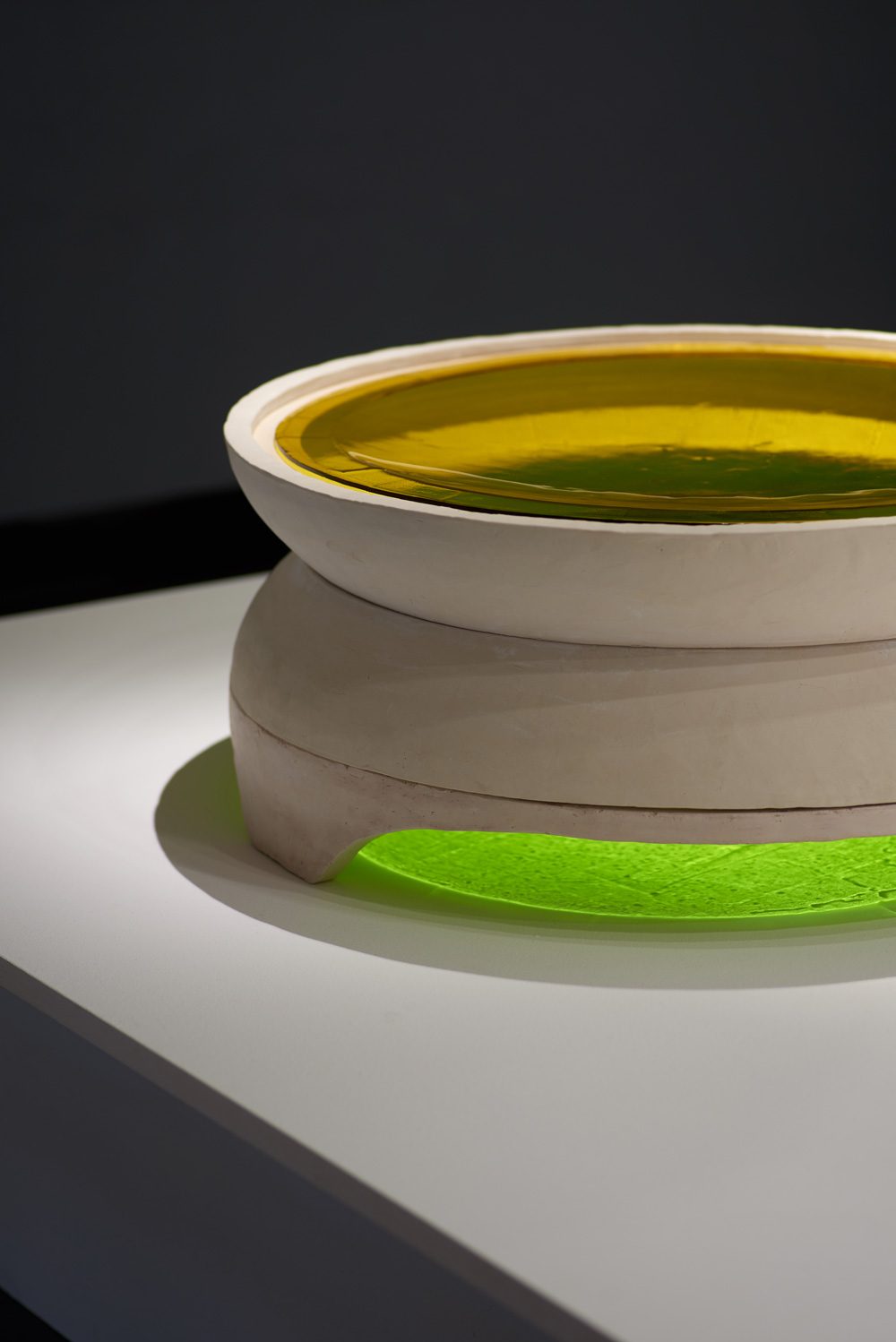
As part of a residency with Eindhoven based foundry Beeldenstorm I developed some projects that took advantage of their warm glass facilities.
The structure of this bowl references the stacked glass elements in a camera lens. Two pieces of 6mm fused glass rest apposed to each other in the form of convex domes. The upper yellow dish is very shallow, while the green dome below has a depth of 20cm and reaches upward to almost touch the bottom of the dish above.
Version 2 has the addition of a foot ring which allows the light passed through the glass to be visible beneath the piece.
Top picture photography: Ronald Smits and Dutch Invertuals
In collaboration with Beeldenstorm

This is a scale model for a larger, massive column. The earthenware clay was mixed with a high ratio of grog to support massive 2cm thick walls which sandwich layers of 6mm fused glass.
The opening at the front of the piece is large enough for a hand, but is primariliy intended to allow a view into the inside of the chamber which mmake a colour gradient.
Photography: Ronald Smits and Dutch Invertuals
In collaboration with Beeldenstorm

When primal instincts, desires, emotions and fears rise from the bottom of our subconscious to the forefront of our awareness we are forced to reconcile our waking consciousness in the material world with the primal elements that make us human. In this moment we are forced to reconcile how and why we are being alienated from a familiar or otherwise banal situation. The experience of searching for the ‘how’ and ‘why’ of this situation is defined as Uncanny. The most common example of this experience is Déjà vu, where a person is lost as to whether they experience the same situation twice, or possibly had a dream with the exact scenario. Since the seminal writing on this concept in 1919 by Freud, Das Unheimliche, artists, writers, film makers and engineers have explored the experience within their medium to create a deeper, more visceral connection with their audience. The projects Disruptive Fundamentals and Omnipotence of Thought are explorations in bringing this concept to Design with a focus on how archetypes and familiar shapes within designed objects can become a vehicle for the subconscious to rise out of the depths of our being.
For instance, the water carafe has a lip which indicates that it is a pouring vessel. However where the handle should be there is a void, a small opening similar to the one you may find at the base of a tree in a forest housing some kind of wildlife. One of the several motifs of the Uncanny are dismembered body parts as humans are predisposed to what is called the ‘castration complex’. We have an innate fear of losing extremities and appendages, and therefore are instinctually repulsed by scenarios where these elements could be in jeopardy. The pouring lip of the carafe indicates logically that a handle is located behind it. But when the user is confronted with the dark, hand-sized void, their knowledge of a basic functional archetype and their primal instincts conflict, and they are forced reconcile their subconscious with the object before them.
This piece was also part of a material research into the use of milk as a low fire glaze for ceramics.
Presented with (pictured):
The Graduate(s) Carpenters Workshop Gallery, London, 2017.
A chiminea is a small movable chimney. In the case of this design there is an inner vessel attached to the lid, so it is essentially two nesting vessels. The concept behind this piece comes from trying to take an element of film making and apply it to design.
In films directors often make use of a dramatic, long and slow reveal of a situation in order to build suspense and give the audience a more visceral sensation of being in the moment. I wanted to apply this mechanism to design in order to control the amount of time a user would be totally engaged with an object.

The second development of the thesis project, Disruptive Fundamentals, this group went further with both core themes of the Uncanny: strangeness and familiarity. The core conceptual elements that went into the Carafe were developed into the Water Vessel which ended up becoming a massive body extension more so than a separate object. The repeated use of the basic cylinder was the consistent thread of familiarity woven throughout the group.
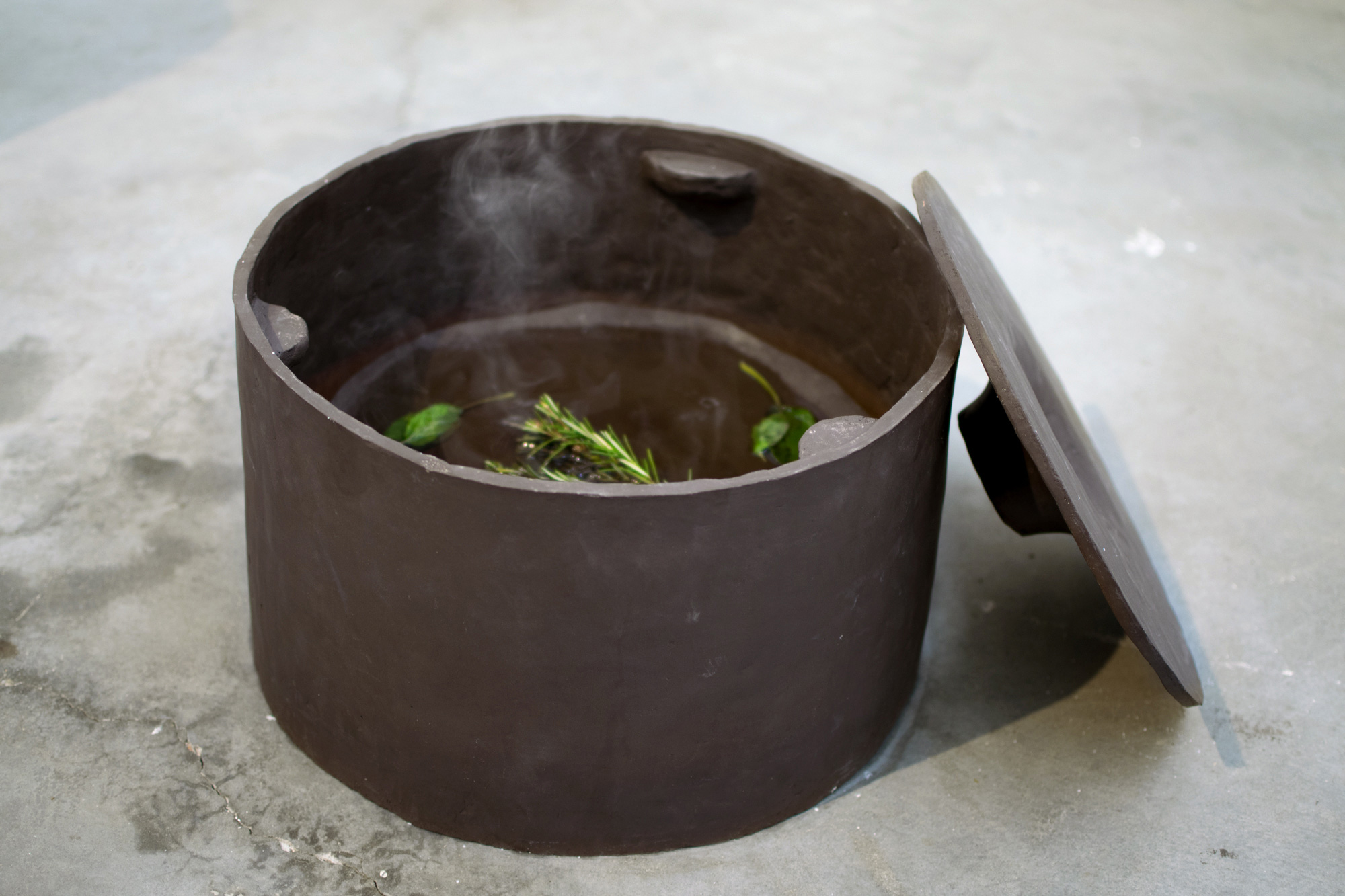
The Humidifer functions when a group of small candles at the bottom of the vessel are lit and heat an evaporation tray which rests in the middle of the vessel. A small amount of water and aromatics slowly burn off as steam.
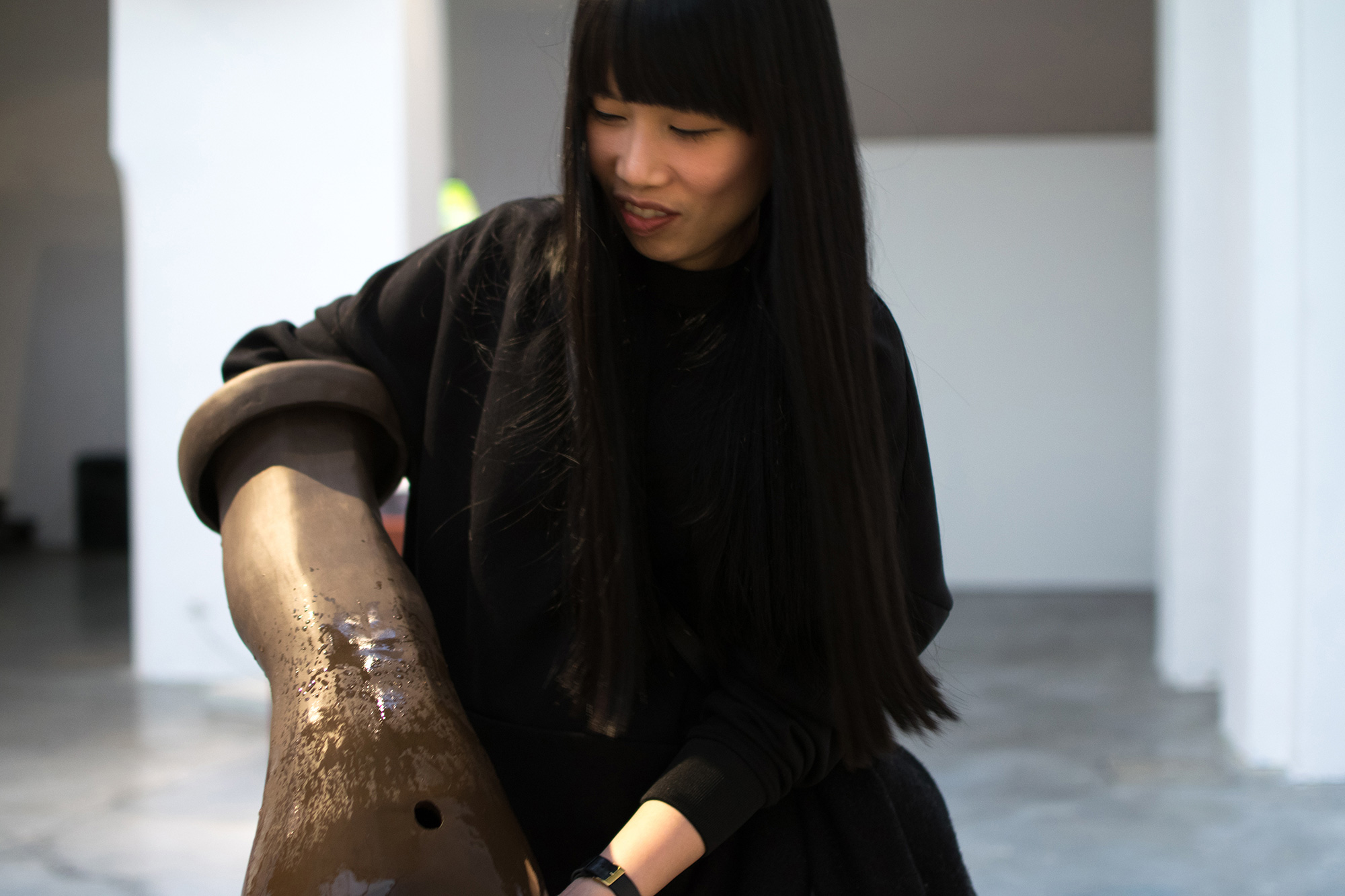
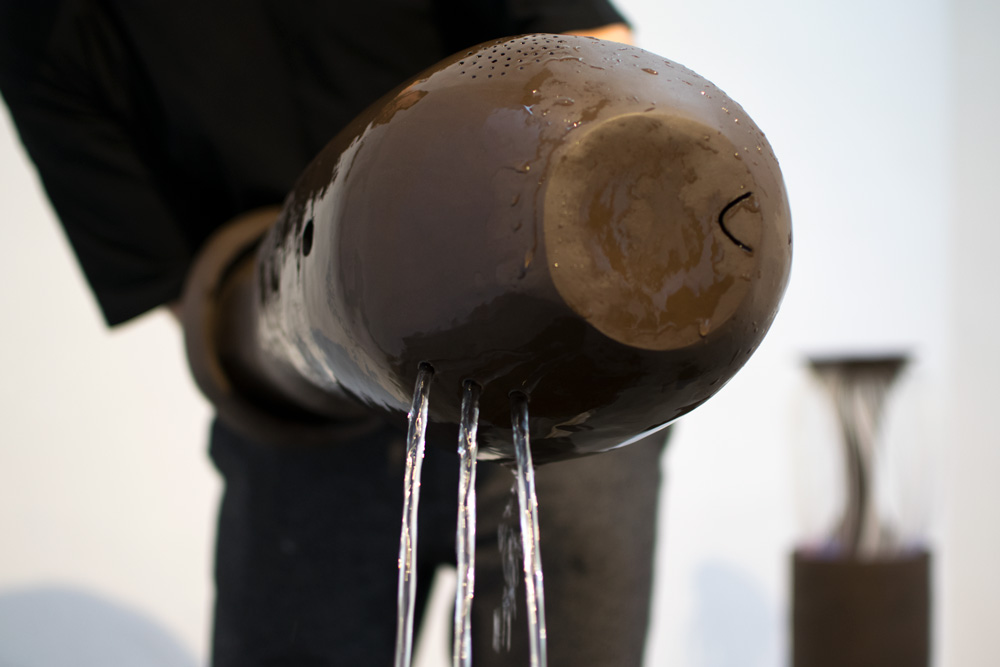
A body extension vessel designed to collect water from a well. Depending how the user rotates the vessel the water pours from one of three openings.
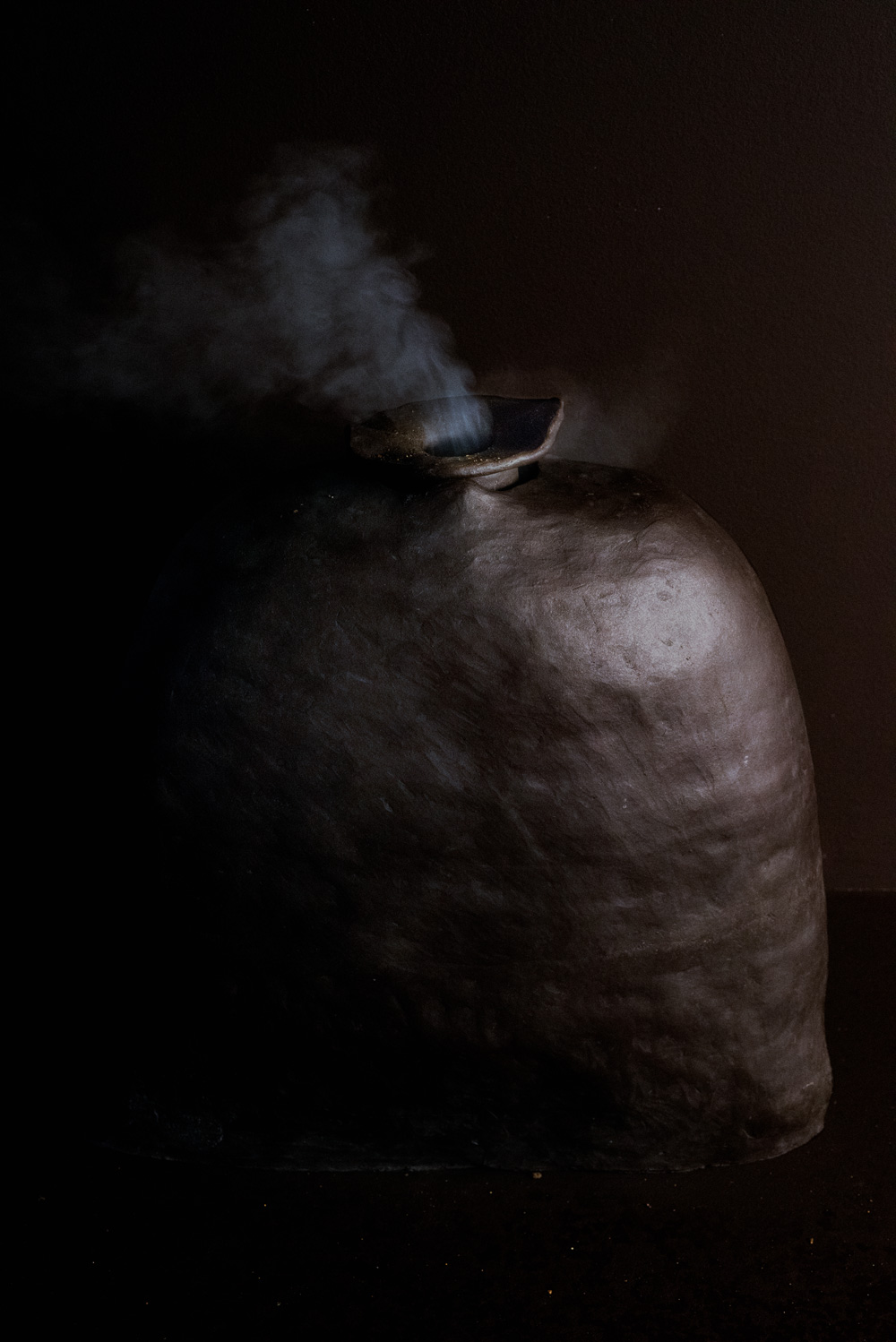
A censer is a vessel used to burn incense, often during religious or spiritual ceremonies. The shape of this censer is derived from its kinetic function. The censer is made of two parts, an outer vessel and an inner pendulum connected to the lid. Inside, the pendulum rocks back and forth connected to the vessel by two pivot points where the lid rests.
At the bottom of the pendulum there is space for a coal and incense which burn and smoke out of the top and sides.

The Handwarmer is comprised of an outer vessel and a nesting inner core that the user can touch. At the bottom of the inner core a candle burns which heats the core and also the air in between the core and the inside of the outer vessel. The front of the outer vessel can be used as a warm resting place for hands, while the inside of the vessel is even warmer as the nesting ceramic vessels insulates the core.
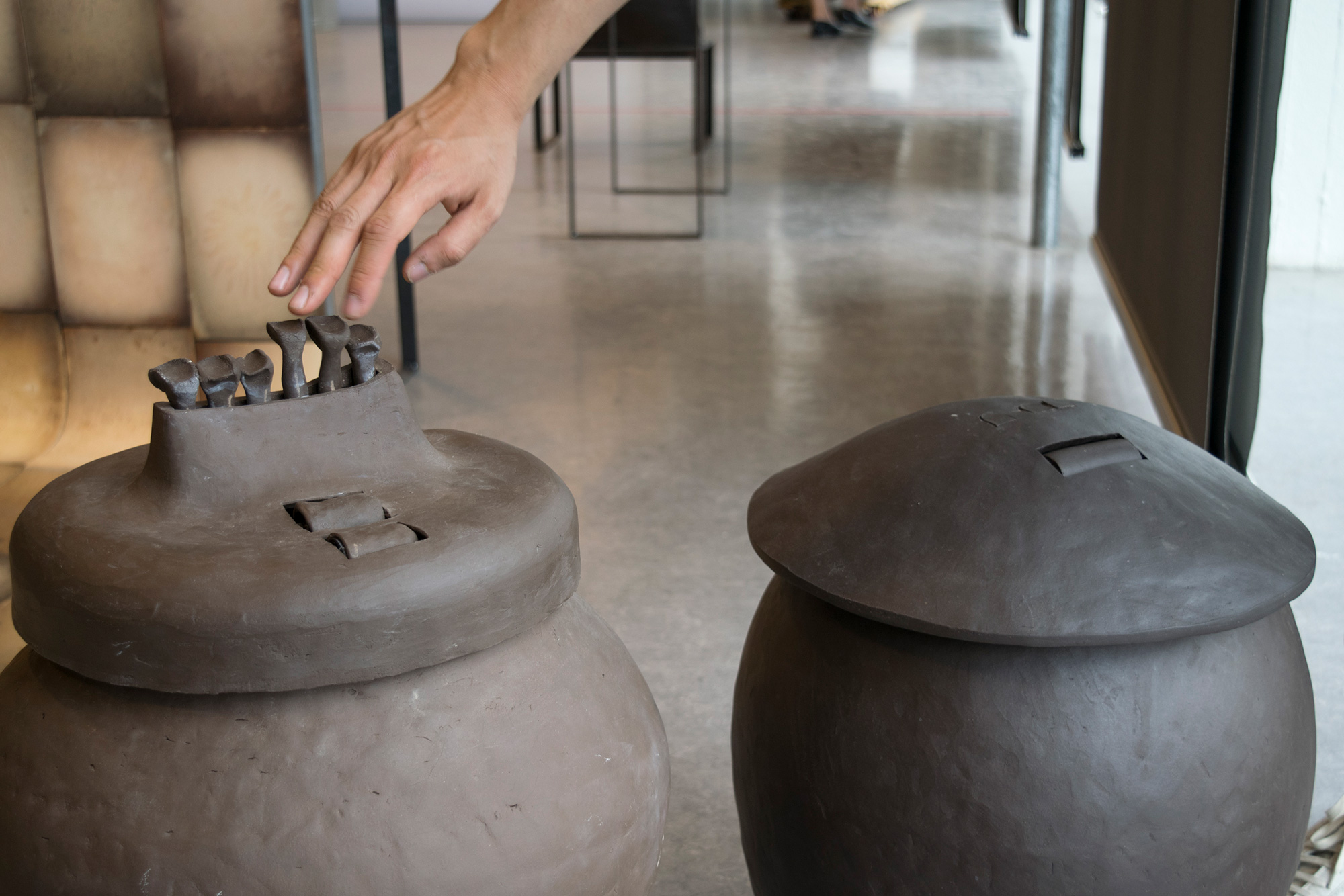
The cassette player is an experiment which combines the tactile qualities of mechanical buttons with hand built ceramics. The inspiration for this juxtaposition came from a core principal of the theory of the Uncanny: the duality of something strange yet simultaneously familiar. The familiar sensation of pushing mechanical buttons subverts the users’ impression of the ceramic vessel. The row of buttons are the basic functions of a cassette player: play, pause, rewind, fast forward, stop. The rolling wheels actuate the left and right volume.
A primary challenge in fabricating this piece was accounting for the shrinkage of all the ceramic parts which eventually had to be retrofitted on top of recycled components from a cassette stereo.
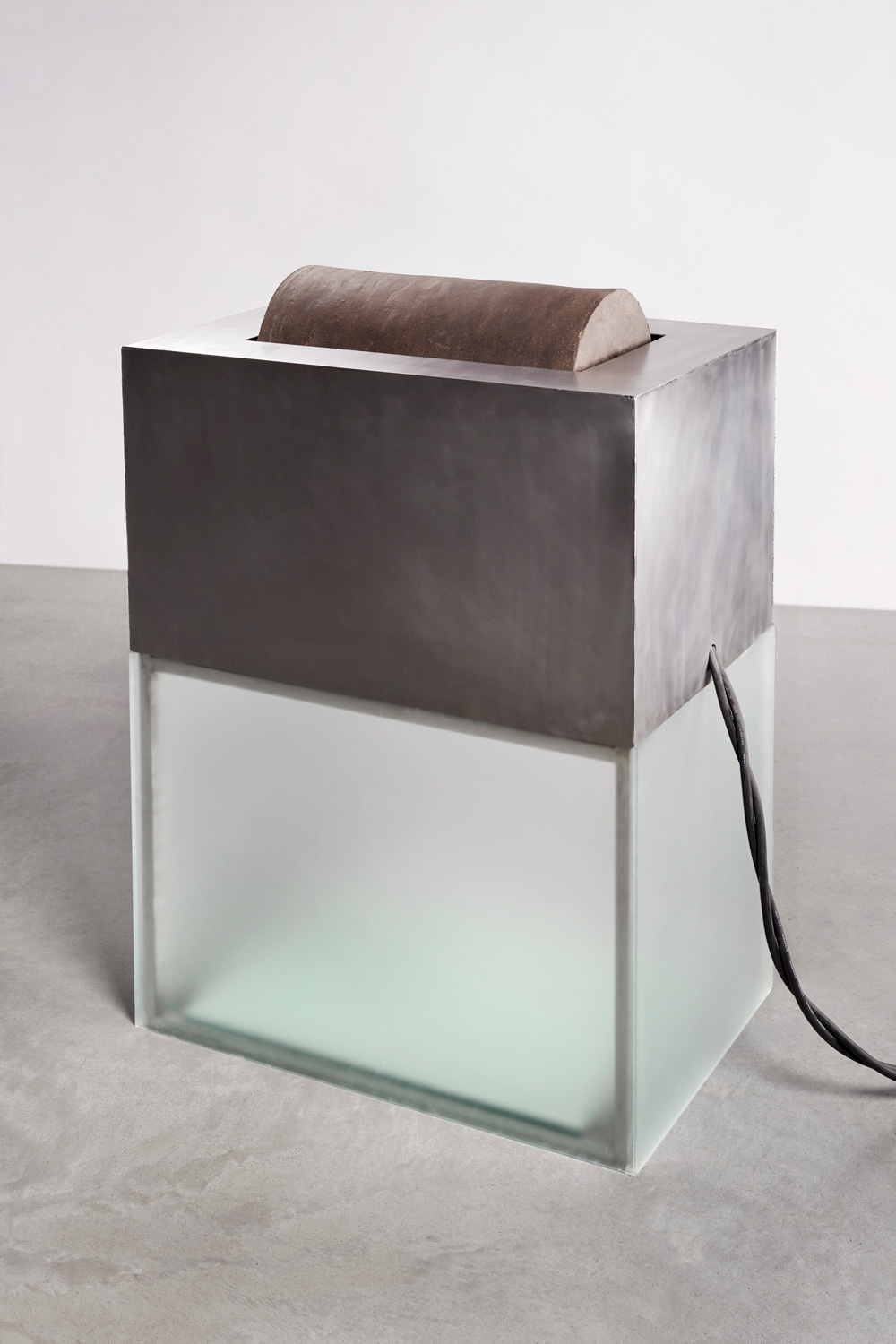
The Scroll Wheel is a response to the new paradigm of scrolling through endless streams of digital content.
Functioning the same as the wheel of a computer mouse, the Scroll Wheel allows users to navigate up and down on a webpage which is diffused by a mirror and etched glass. The device harvests and modifies the screen glow of a digital device, the kind we can observe when we watch someone use a computer or cell phone in a dark room.
Due to the massive nature of the rolling wheel it becomes the primary element of the experience, while the content which is usually the main aspect fixated on is subverted to basic sensory elements (color, moving lines).
Photography: Ronald Smits and Dutch Invertuals